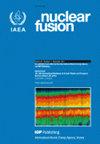带氩杂质的 ADITYA-U 托卡马克中静电微扰的陀螺动力学模拟
IF 4
1区 物理与天体物理
Q1 PHYSICS, FLUIDS & PLASMAS
引用次数: 0
摘要
利用全局陀螺动力学模拟评估了杂质对ADITYA-U托卡马克中静电微扰的影响。模拟采用了 ADITYA-U 在氩气注入前后的真实几何形状和实验剖面。在添加杂质之前,模拟显示在径向-波状平面上的三个不同区域存在困电子模式(TEM)不稳定性。该模式可通过其线性特征模式结构及其在电子二磁方向上的传播特征识别出来。在外核区域加入 Ar1+ 杂质离子的模拟结果表明,由于线性不稳定性驱动力的减弱,湍流和传输较无杂质的情况显著减弱。外核区粒子和热传输的减少改变了杂质添加后测量到的等离子体密度曲线。因此,这导致了核心区域 TEM 不稳定性的稳定。由于湍流活动减少,中心区域的电子和离子温度上升了约 10%。本文章由计算机程序翻译,如有差异,请以英文原文为准。
Gyrokinetic simulations of electrostatic microturbulence in ADITYA-U tokamak with argon impurity
The effect of impurity on the electrostatic microturbulence in ADITYA-U tokamak is assessed using global gyrokinetic simulations. The realistic geometry and experimental profiles of the ADITYA-U are used, before and after argon gas seeding, to perform the simulations. Before the impurity seeding, the simulations show the existence of the trapped electron mode (TEM) instability in three distinct regions on the radial-poloidal plane. The mode is identified by its linear eigenmode structure and its characteristic propagation in the electron diamagnetic direction. The simulations with Ar1+ impurity ions in the outer-core region show a significant reduction in the turbulence and transport due to a reduction in the linear instability drive, with respect to the case without impurity. A decrease in particle and heat transport in the outer-core region modifies the plasma density profile measured after the impurity seeding. It, thus, results in the stabilization of the TEM instability in the core region. Due to the reduced turbulence activity, the electron and ion temperatures in the central region increase by about 10%.
求助全文
通过发布文献求助,成功后即可免费获取论文全文。
去求助
来源期刊

Nuclear Fusion
物理-物理:核物理
CiteScore
6.30
自引率
39.40%
发文量
411
审稿时长
2.6 months
期刊介绍:
Nuclear Fusion publishes articles making significant advances to the field of controlled thermonuclear fusion. The journal scope includes:
-the production, heating and confinement of high temperature plasmas;
-the physical properties of such plasmas;
-the experimental or theoretical methods of exploring or explaining them;
-fusion reactor physics;
-reactor concepts; and
-fusion technologies.
The journal has a dedicated Associate Editor for inertial confinement fusion.
 求助内容:
求助内容: 应助结果提醒方式:
应助结果提醒方式:


